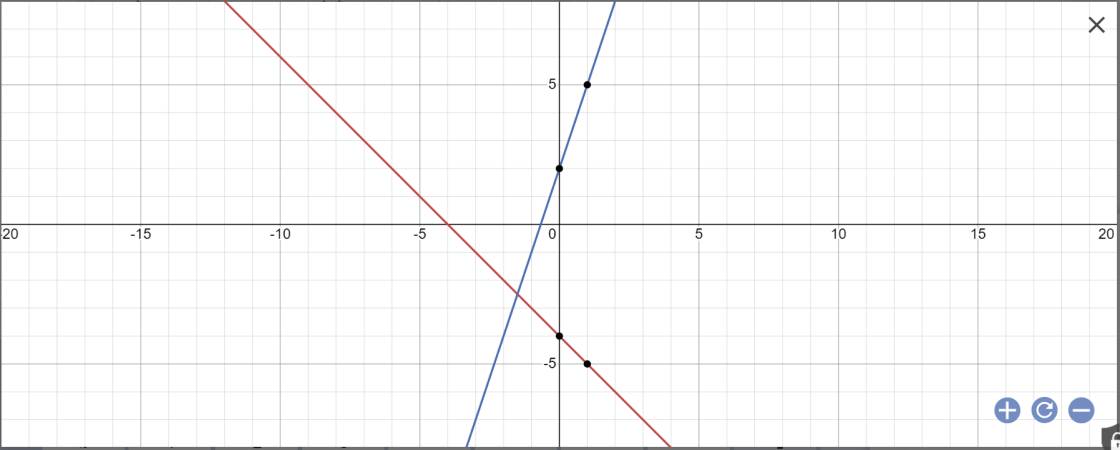Hãy nhập câu hỏi của bạn vào đây, nếu là tài khoản VIP, bạn sẽ được ưu tiên trả lời.

Câu 1:
a,Bạn tự vẽ
b,Phương trình hoành độ giao điểm của (d1) và (d2) là:
\(\(\(-2x+3=x-1\Rightarrow-3x=-4\Rightarrow x=\frac{4}{3}\)\)\)
\(\(\(\Rightarrow y=\frac{4}{3}-1=\frac{1}{3}\)\)\)
Vậy tọa độ giao điểm của (d1) và (d2) là \(\(\(\left(\frac{4}{3};\frac{1}{3}\right)\)\)\)
c,Đường thẳng (d3) có dạng: y = ax + b
Vì (d3) song song với (d1) \(\(\(\Rightarrow\hept{\begin{cases}a=a'\\b\ne b'\end{cases}}\Rightarrow\hept{\begin{cases}a=-2\\b\ne3\end{cases}}\)\)\)
Khi đó (d3) có dạng: y = -2x + b
Vì (d3) đi qua điểm A( -2 ; 1) nên \(\(\(\Rightarrow x=-2;y=1\)\)\)
Thay x = -2 ; y = 1 vào (d3) ta được:\(\(\(1=-2.\left(-2\right)+b\Rightarrow b=-3\)\)\)
Vậy (d3) có phương trình: y = -2x - 3
Câu 2:
\(A=\frac{a\sqrt{b}+b\sqrt{a}}{\sqrt{ab}}:\frac{1}{\sqrt{a}-\sqrt{b}}\left(a>0;b>0;a\ne b\right)\)(Đề chắc phải như này)
\(\(\(=\frac{\sqrt{ab}\left(\sqrt{a}+\sqrt{b}\right)}{\sqrt{ab}}.\frac{\sqrt{a}-\sqrt{b}}{1}\)\)\)
\(\(\(=\left(\sqrt{a}+\sqrt{b}\right)\left(\sqrt{a}-\sqrt{b}\right)\)\)\)
\(\(\(=\sqrt{a}^2-\sqrt{b}^2\)\)\)
\(\(\(=a-b\)\)\)

Bài 2:
a: (d): y=ax+b
Theo đề, ta có:
\(\left\{{}\begin{matrix}a\sqrt{2}+b=1\\a\cdot0+b=3\sqrt{2}+1\end{matrix}\right.\Leftrightarrow\left\{{}\begin{matrix}b=3\sqrt{2}+1\\a=\dfrac{1-b}{\sqrt{2}}=\dfrac{1-3\sqrt{2}-1}{\sqrt{2}}=-3\end{matrix}\right.\)
b: Tọa độ giao của (d1) và (d2) là:
2/5x+1=-x+4 và y=-x+4
=>7/5x=3và y=-x+4
=>x=15/7 và y=-15/7+4=13/7
Vì (d) đi qua B(15/7;13/7) và C(1/2;-1/4)
nên ta có hệ:
15/7a+b=13/7 và 1/2a+b=-1/4
=>a=59/46; b=-41/46

Bài 1 :
\(\dfrac{x+4}{x^2-9}-\dfrac{2}{x+3}=\dfrac{4x}{3x-x^2}\) ( ĐK : \(\left\{{}\begin{matrix}x\ne0\\x\ne-3\\x\ne3\end{matrix}\right.\) )
\(\Leftrightarrow\dfrac{x\left(x+4\right)}{x\left(x-3\right)\left(x+3\right)}-\dfrac{2x\left(x-3\right)}{x\left(x-3\right)\left(x+3\right)}=\dfrac{-4x\left(x+3\right)}{x\left(x-3\right)\left(x+3\right)}\)
\(\Leftrightarrow x\left(x+4\right)-2x\left(x-3\right)=-4x\left(x+3\right)\)
\(\Leftrightarrow x^2+4x-2x^2+6x+4x^2+12x=0\)
\(\Leftrightarrow3x^2+22x=0\)
\(\Leftrightarrow x\left(3x+22\right)=0\)
\(\Leftrightarrow\left[{}\begin{matrix}x=0\\3x+22=0\end{matrix}\right.\Leftrightarrow\left[{}\begin{matrix}x=0\left(L\right)\\x=-\dfrac{22}{3}\left(N\right)\end{matrix}\right.\)
Vậy \(x=-\dfrac{22}{3}\)
Bài 2 : \(x\left(x+1\right)\left(x^2+x+1\right)=42\)
\(\Leftrightarrow\left(x^2+x\right)\left(x^2+x+1\right)=42\)
Đặt \(x^2+x=t\) . Phương trình trở thành :
\(t\left(t+1\right)=42\)
\(\Leftrightarrow t^2+t-42=0\)
\(\Leftrightarrow\left(t-6\right)\left(t+7\right)=0\)
\(\Leftrightarrow\left[{}\begin{matrix}t-6=0\\t+7=0\end{matrix}\right.\Leftrightarrow\left[{}\begin{matrix}t=6\\t=-7\end{matrix}\right.\)
Với \(t=6\)
\(\Leftrightarrow x^2+x=6\)
\(\Leftrightarrow x^2+x-6=0\)
\(\Leftrightarrow\left(x-2\right)\left(x+3\right)=0\)
\(\Leftrightarrow\left[{}\begin{matrix}x-2=0\\x+3=0\end{matrix}\right.\Leftrightarrow\left[{}\begin{matrix}x=2\\x=-3\end{matrix}\right.\)
Với \(t=-7\)
\(\Leftrightarrow x^2+x=-7\)
\(\Leftrightarrow x^2+x+7=0\)
---> Phương trình vô nghiệm !
Vậy \(x=-3;x=2\)
Câu 1:
a: \(\dfrac{2}{5}\sqrt{75}-0,5\cdot\sqrt{48}+\sqrt{300}-\dfrac{2}{3}\cdot\sqrt{12}\)
\(=\dfrac{2}{5}\cdot5\sqrt{3}-0,5\cdot4\sqrt{3}+10\sqrt{3}-\dfrac{2}{3}\cdot2\sqrt{3}\)
\(=2\sqrt{3}-2\sqrt{3}+10\sqrt{3}-\dfrac{4}{3}\sqrt{3}\)
\(=10\sqrt{3}-\dfrac{4}{3}\sqrt{3}=\dfrac{26}{3}\sqrt{3}\)
b: \(\dfrac{9-2\sqrt{3}}{3\sqrt{6}-2\sqrt{2}}+\dfrac{3}{3+\sqrt{6}}\)
\(=\dfrac{\sqrt{3}\cdot3\sqrt{3}-2\sqrt{3}}{\sqrt{2}\left(3\sqrt{3}-2\right)}+\dfrac{3\left(3-\sqrt{6}\right)}{9-6}\)
\(=\dfrac{\sqrt{3}\left(3\sqrt{3}-2\right)}{\sqrt{2}\left(3\sqrt{3}-2\right)}+3-\sqrt{6}\)
\(=\dfrac{\sqrt{3}}{\sqrt{2}}+3-\sqrt{6}=3-\dfrac{\sqrt{6}}{2}\)
c: \(\sqrt{15-6\sqrt{6}}+\sqrt{33-12\sqrt{6}}\)
=\(\sqrt{9-2\cdot3\cdot\sqrt{6}+6}+\sqrt{24-2\cdot2\sqrt{6}\cdot3+9}\)
\(=\sqrt{\left(3-\sqrt{6}\right)^2}+\sqrt{\left(2\sqrt{6}-3\right)^2}\)
\(=\left|3-\sqrt{6}\right|+\left|2\sqrt{6}-3\right|\)
\(=3-\sqrt{6}+2\sqrt{6}-3=\sqrt{6}\)
Bài 2:
a:
b: Phương trình hoành độ giao điểm là:
\(3x+2=-x-4\)
=>4x=-6
=>x=-3/2
Thay x=-3/2 vào y=-x-4, ta được:
\(y=-\left(-\dfrac{3}{2}\right)-4=\dfrac{3}{2}-4=-\dfrac{5}{2}\)
Vậy: \(A\left(-\dfrac{3}{2};-\dfrac{5}{2}\right)\)
c: Vì (d2)//(d) nên \(\left\{{}\begin{matrix}a=-1\\b\ne-4\end{matrix}\right.\)
Vậy: (d2): y=-x+b
Thay x=-2 và y=5 vào (d2), ta được:
\(b-\left(-2\right)=5\)
=>b+2=5
=>b=5-2=3
Vậy: (d2): y=-x+3